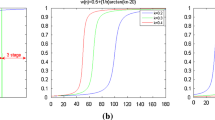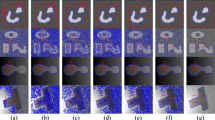Abstract
A novel active contour model is proposed by combining region and edge information. Its level set formulation consists of the edge-related term, the region-based term and the regularization term. The edge-related term is derived from the image gradient, and facilitates the contours evolving into object boundaries. The region-based term is constructed using both local and global statistical information, and related to the direction and velocity of the contour propagation. The last term ensures stable evolution of the contours. Finally, a Gaussian convolution is used to regularize the level set function. In addition, a new quantitative metric named modified root mean squared error is defined, which can be used to evaluate the final contour more accurately. Experimental results show that the proposed method is efficient and robust, and can segment homogenous images and inhomogenous images with the initial contour being set freely.
Similar content being viewed by others
References
Kass M., Witkin A., Terzopoulos D.: Snake: active contour models. Int. J. Comput. Vis. 1(4), 321–331 (1988)
Chan T., Vese L.: Active contours without edges. IEEE Trans. Image Process. 10(2), 266–277 (2001)
Paragios N., Deriche R.: Geodesic active regions and level set methods for supervised texture segmetnation. Int. J. Comput. Vis. 46(3), 223–247 (2002)
Zhao H., Chan T., Merriman B., Osher S.: A variational level set approach to multiphase motion. J. Comput. Phys. 127(1), 179–195 (1996)
Blanc-Freaud C.Samson.L., Aubert G., Zerubia J.: A variational model for image classification and restoration. IEEE Trans. Pattern Anal. Mach. Intell. 22(5), 460–472 (2000)
Tsai A., Yezzi A., Willsky A.S.: Curve evolution implementation of the Mumford–Shah Functional for image segmentation, denoising, interpolation, and magnification. IEEE Trans. Image Process. 10(8), 1169–1186 (2001)
Hernandez M., Frangi A.F.: Non-parametric geodesic active regions: method and evaluation for cerebral aneurysms segmentation in 3DRA and CTA. Med. Image Anal. 11(3), 224–241 (2007)
Rousson, M., Deriche, R.: A variational framework for active and adaptive segmentation of vector valued images. In: Proceedings of the Workshop on Motion and Video Computing (MOTION’02), pp. 56–61. Orlando (2002)
Xu C., Prince J.: Snakes, shapes, and gradient vector flow. IEEE Trans. Image Process. 7(3), 359–369 (1998)
Li, C., Xu, C., Gui, C., Fox, M.D.: Level set evolution without re-initialization: A new variational formulation. In: IEEE Conference on Computer Vision and Pattern Recognition, pp. 430–436. San Diego (2005)
Sundaramoorthi, G., Yezzi, A., Mennucci, A.C., Sapiro, G.: New possibilities with Sobolev active contours. In: Proceedings of SSVM, pp. 153–164. Ischia (2007)
Caselles V., Kimmel R., Sapiro G.: Geodesic active contours. Int. J. Comput. Vis. 22(1), 61–79 (1997)
Kishenassamy, S., Kumar, A., Olver, P., Tannenbaum, A., Yezzi, A.: Gradient flows and geometric active contour models. In: Processing of IEEE International Conference on Computer Vision’95, pp. 810–815. Boston (1995)
Vasilevskiy A., Siddiqi K.: Flux-maximizing geometric flows. IEEE Trans. Pattern Anal. Mach. Intell. 24(12), 1565–1578 (2002)
Ronfard R.: Region-based strategies for active contour models. Int. J. Comput. Vis. 13(2), 229–251 (1994)
Vese L., Chan T.: A multiphase level set framework for image segmentation using the Mumford and Shah model. Int. J. Comput. Vis. 50(3), 271–293 (2002)
Pichon E., Tanenbaum A., Kikins R.: A statistically based fow for image segmentation. Med. Image Anal. 8(3), 267–274 (2004)
Kim J., Fisher J., Yezzi A.: A nonparametric statistical method for image segmentation using information theory and curve evolution. IEEE Trans. Image Process. 14(10), 1486–1502 (2005)
Paragios, N.K.: Geodesic active regions and level set methods: Contributions and applications in artificial vision, PhD thesis, University of Nice Sophia Antipolis, January 2000
Zhang K., Zhang L., Song H., Zhou W.: Active contours with selective local or global segmentation: a new formulation and level set method. Image Vis. Comput. 28(4), 668–676 (2010)
Allili M.S., Ziou D.: Globally adaptive region information for automatic color–texture image segmentation. Pattern Recognit. Lett. 28(15), 1946–1956 (2007)
Malladi R., Sethian J.A., Vemuri B.C.: Shape modeling with front propagation: a level set approach. IEEE Trans. Pattern Anal. Mach. Intell. 17(2), 158–175 (1995)
Chen Y., Tagare H.D., Thiruvenkadam S., Huang F., Wilson D., Gopinath K.S., Briggs R.W., Geiser E.A.: Using prior shapes in geometric active contours in a variational framework. Int. J. Comput. 50(3), 315–328 (2002)
de Bruijne, M., van Ginneken, B., Niessen, W.J., Viergever, M.A.: Active shape model segmentation using a non-linear appearance model: application to 3D AAA segmentation, Technical report UU-CS-2003-013, Institute of Information and Computing Sciences, Utrecht University (2003)
Bresson X., Vandergheynst P., Thiran J.: A variational model for object segmentation using boundary information and shape prior driven by the Mumford-shad functional. Int. J. Comput. Vis. 68(2), 145–162 (2006)
Jolly, M.: Combining edge, region, and shape information to segment the left ventricle in cardiac MR images. In: Proceedings of MICCAI, pp. 482–490. Utrecht (2001)
Leventon, M.E., Grimson, W.E.L., Faugeras, O.: Statistical shape influence in geodesic active contours. In: IEEE Conference on Computer Vision and Pattern Recognition, pp. 316–323. Hilton Head Island (2000)
Mumford D., Shah J.: Optimal approximations by piecewise smooth functions and associated variational problems. Commun. Pure Appl. Math. 42(5), 577–685 (1989)
Ksantini, R., Shariat, F., Boufama, B.: An efficient and fast active contour model for salient object detection. In: IEEE Canadian Conference on Computer and Robot Vision, pp. 124–131. Kelowna, BC (2009)
Li, C., Kao, C., Gore, J.C., Ding, Z.: Implicit active contours driven by local binary fitting energy. In: IEEE Conference on Computer Vision and Pattern Recognition, pp.1–7. Washington, DC (2007)
Li C., Kao C., Gore J.C., Ding Z.: Minimization of region-scalable fitting energy for image segmentation. IEEE Trans. Image Process. 17(10), 1940–1949 (2008)
Li, C., Xu, C., Anderson, A.W., Gore, J.C.: MRI tissue classification and bias field estimation based on coherent local intensity clustering: A unified energy minimization framework. In: International Conference on Information Processing in Medical Imaging (IPMI’09), pp.288–299. Williamsburg (2009)
Lankton, S., Nain, D., Yezzi, A., Tannenbaun, A.: Hybrid geodesic region-based curve evolutions for image segmentation. In: SPIE Medical Imaging 2007 Symposium, 6510 (2007)
Wang L., Hei L., Mishra A., Li C.: Active contours driven by local Gaussian distribution fitting energy. Signal Process. 89(12), 2435–2447 (2009)
Zhang K., Song H., Zhang L.: Active contours driven by local image fitting energy. Pattern Recognit. 43(4), 1199–1206 (2010)
Liu, H., Chen, Y., Chen, W.: Neighborhood aided implicit active contours. In: IEEE Conference on Computer Vision and Pattern Recognition, pp. 841–848. HK, China (2006)
Xu, C., Yezzi Jr., A., Prince, J.: On the relationship between parametric and geometric active contours. In: Processing of 34th Asilomar Conference on Signals Systems and Computers, pp. 483–489. Pacific Grove (2000)
Osher S., Fedkiw R.: Level Set Methods and Dynamic Implicit Surfaces. Springer, New York (2002)
Bresson, X., Chan, T.F.: Non-local unsupervised variational image segmentation models, CAM-report-08-67. Department of Mathematics, University of California, Los Angeles (2008)
Grandall M.G., Evans L.C., Gariepy R.F.: Optimal Lipschitz extensions and the infinity Laplacian. Calc. Var. Partial Differ. Equ. 13(2), 123–139 (2001)
Perona P., Malik J.: Scale-space and edge detection using anisotropic diffusion. IEEE Trans. Pattern Anal. Mach.Intell. 12(7), 629–640 (1990)
Shi, Y., Karl, W.C.: Real-time tracking using level sets. In: IEEE Conference on Computer Vision and Pattern Recognition, pp. 31–34. San Diego (2005)
Author information
Authors and Affiliations
Corresponding author
Rights and permissions
About this article
Cite this article
Tian, Y., Duan, F., Zhou, M. et al. Active contour model combining region and edge information. Machine Vision and Applications 24, 47–61 (2013). https://doi.org/10.1007/s00138-011-0363-7
Received:
Revised:
Accepted:
Published:
Issue Date:
DOI: https://doi.org/10.1007/s00138-011-0363-7




